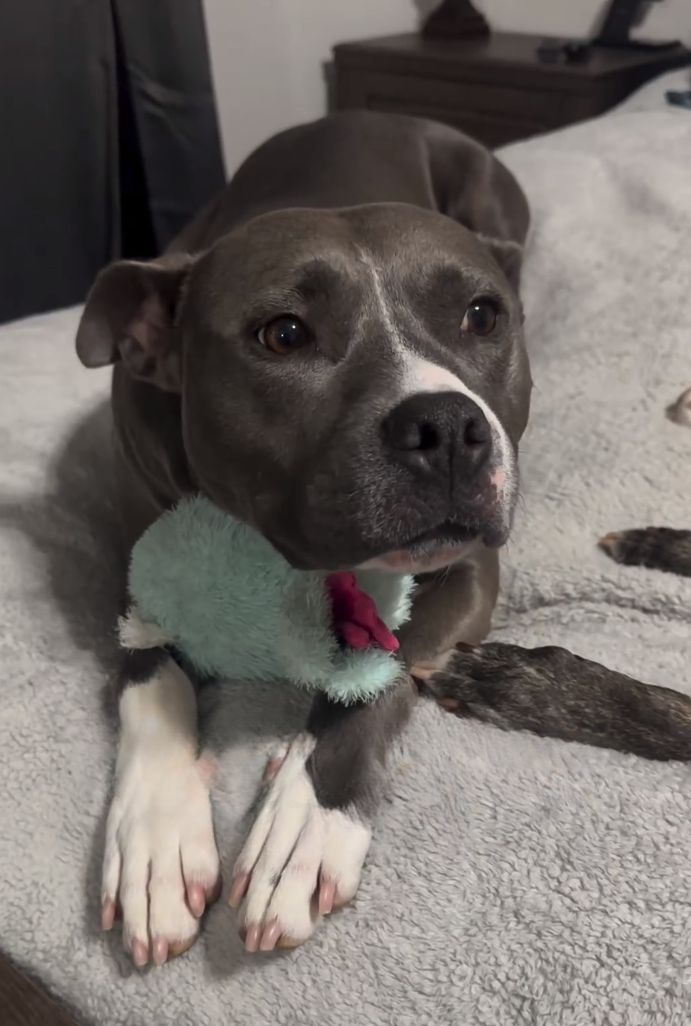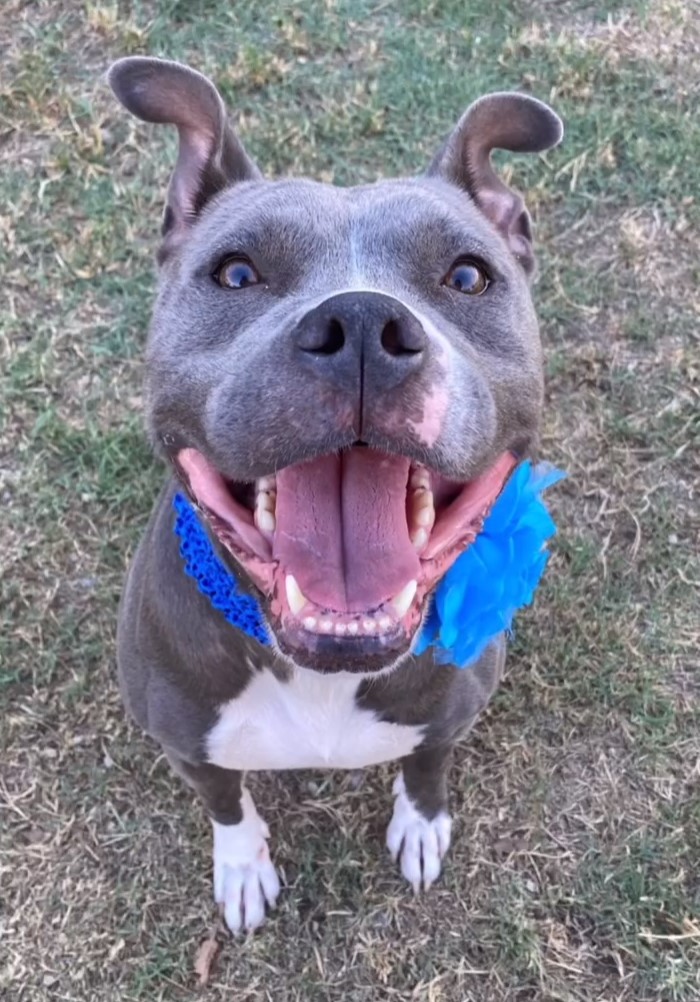When an adorable Pit Bull by the name of Shelly was surrendered to a shelter because her family was having a baby, she felt confused, depressed, and betrayed.
Unfortunately, since it is very hard for pups of her breed to be adopted, Shelly was placed on the euthanization list three weeks after arriving at the shelter.
Shelly gave up all hope of being a part of a forever family until an incredible hooman found out about her sad fate and decided to turn it around completely.
Second Chance

As soon as Lacey, Shelly’s new owner, heard that she was scheduled to be put down the very next morning and “had to be out of the building that day”, she opened up her arms and took her into her loving home.
“Unfortunately there are so many pit breeds in the shelter that are in perfectly healthy condition that get overlooked,” Lacey told Newsweek.
Being a determined volunteer at the shelter, Lacey knew that Shelly could make so many hoomans happy if she was only given the chance. So, she decided to offer her a helping hand by taking her in.

“We wanted to foster because I knew she could find a good home if she was just given more time,” she added.
Over time, Lacey’s assumption was proven right; however, not the way she imagined it when she first signed up to be Shelly’s foster.
“We had just adopted one new dog, so we initially thought getting two more on top of the one we had would be too much. But Shelly and our other new dog got along so well and felt so safe with each other. They were bonded almost instantly. It helped that they were both extremely well-behaved and both dog- and people-friendly. So I thought it was best to just keep them together,” Lancey stated.
Finally, Shelly was a part of a family who loved and adored her for who she truly was.
Shelly adores her adoptive brother and her new family. She also makes sure to spread her happiness by greeting every hooman she comes across.

She is now living the life of every pup’s dreams! Her days are full of fun playdates, loving memories, and pawsome adventures.
End The Prejudice
It fills my heart knowing that this sweet girl was not only offered a second chance at life but also given her happily ever after.
But, it also brings me to tears knowing that she was placed in such an unfortunate situation all because of her breed.
A lot of hoomans, unfortunately, are quick to judge Pit Bulls because they believe all of the stereotypes surrounding them.
Please know that these sweet creatures are no more aggressive than other breeds out there. They are extremely gentle, loyal, and loving companions who will do anything to ensure that their hoomans always have a smile on their faces.
It is crucial to let go of these prejudices and know that every doggo, regardless of their breed, deserves to be loved and cherished!
Have you ever noticed your furry friend showering your hands with slobbery kisses? It’s a common behavior that many dog owners experience. Your pup’s affectionate licks may seem endearing, but have you ever wondered why they do it? Understanding the reasons behind this quirky habit can provide insights into your dog’s emotions and communication style. Let’s take a closer look at why your canine companion enjoys licking your hands.
Understanding Canine Behavior: The Basics of Licking
The Role of Licking in Canine Communication
Dogs use licking as a primary form of communication. When your furry friend licks your hands, it’s their way of expressing affection and forming a bond with you. This behavior dates back to their wolf ancestors, where licking was a way to groom and care for pack members. So, next time your dog showers you with licks, know that it’s their way of showing love and seeking closeness.
What Licking Means in Dog-to-Human Interactions
In dog-to-human interactions, licking serves various purposes. It can be a sign of submission, respect, or a way for your dog to gather information about you through taste and scent. Additionally, licking releases endorphins in dogs, promoting a sense of well-being. So, when your pup licks your hands, they might be trying to communicate their feelings, show respect, or simply enjoy the comforting sensation it brings.
Remember, understanding why your dog licks your hands can deepen your bond with your furry companion and enhance your relationship. Watch for subtle cues in their behavior to decipher what they might be trying to communicate through this endearing habit.
The Science Behind Why Dogs Lick Human Hands
Licking as a Sign of Affection
Dogs show their love by licking your hands. This behavior stems from their puppy days when mother dogs licked their pups to communicate care and affection. By licking you, your dog is bonding and expressing affection, much like a family member’s hug.
Taste and Smell: Sensory Factors in Licking
A dog’s sense of taste and smell is extraordinary. When they lick your hands, they’re not just tasting the saltiness but also gathering information about your recent activities. They can decipher where you’ve been, what you’ve touched, and even your emotional state through scent.
Licking as a Submission Gesture
Licking can also be a way for your dog to show respect and submission to you. In the canine world, licking is a polite gesture to higher-ranking members of the pack. So, when your dog licks your hands, they might be acknowledging your leadership and showing deference.
Health and Hygiene Concerns with Hand Licking
Potential Health Risks for Humans
When your dog licks your hands, it’s a sweet gesture, but it’s essential to be aware of potential health risks. Your pup’s mouth carries bacteria that can transfer to your skin through licking. While most of these bacteria are harmless to humans, some strains could cause infections, especially if you have any cuts or sores on your hands. Additionally, if your dog has been eating something unsanitary, there is a risk of transferring pathogens from their mouth to your skin.
How to Keep Your Dog’s Licking Hygienic
Maintaining good hygiene practices is crucial to ensure that your dog’s licking stays safe for both of you. Regularly wash your hands with soap and water, especially after your dog licks them. Keep your pup’s mouth clean and healthy by providing them with proper dental care, including regular teeth brushing and dental check-ups. If you notice any excessive licking behavior or changes in your dog’s licking habits, consult your veterinarian to rule out any underlying health issues. Remember, a little care goes a long way in keeping your furry friend’s kisses enjoyable and safe for you.
Training Your Dog: Managing Excessive Licking
Positive Reinforcement Techniques
When it comes to managing your dog’s excessive licking, positive reinforcement can be a valuable tool. You can use treats, praise, or rewards to encourage alternative behaviors. For example, when your dog refrains from licking your hands and instead sits calmly, reward them with a treat or a kind word. This helps your dog associate good behavior with positive outcomes, gradually reducing the excessive licking.
Establishing Boundaries With Your Pet
Setting boundaries with your pet is crucial in addressing excessive licking. Consistency is key here. If you don’t want your dog to lick your hands, gently redirect their behavior each time they attempt to do so. You can use verbal cues like “no lick” or “off” while offering an alternative behavior to focus on, such as sitting or giving you their paw. With patience and consistency, your dog will understand the boundaries you’ve set and learn to respect them.
Alternatives to Hand-Licking
Providing Suitable Licking Substitutes
If you want to redirect your dog’s licking behavior, you can offer them appropriate items to lick instead of your hands. For instance, you can give your dog a safe chew toy, a frozen treat, or a dental chew. These options will not only keep them occupied but also satisfy their need for oral stimulation.
Encouraging Other Forms of Affection
To discourage hand-licking, you can encourage your dog to engage in alternative forms of affection. One way is to teach them commands like “sit,” “stay,” or “fetch,” reinforcing positive behavior without the need for licking. Another approach is to pet them gently, offer belly rubs, or engage in playtime to show your affection and strengthen your bond without the licking behavior.
Conclusion
Your dog’s habit of licking your hands is a way of showing love, respect, and curiosity. It’s a natural behavior that can bring joy and comfort to both of you. While it’s essential to consider hygiene and potential risks, there are ways to manage excessive licking positively. By setting boundaries, using redirection techniques, and offering suitable alternatives, you can encourage more balanced interactions with your furry friend. Remember, building a strong bond doesn’t always require hand-licking; engaging in various activities and training sessions can deepen your connection and create lasting memories together. Enjoy the special moments with your pup while understanding and respecting their unique way of expressing themselves.
Frequently Asked Questions
Why do dogs lick their owner’s hands?
Dogs lick their owner’s hands as a form of communication to show affection, submission, and gather information. It releases endorphins in dogs, promoting a sense of well-being.
Is there a risk of bacterial transfer from dog licking?
Yes, there is a risk of bacterial transfer from dog licking. It is advisable to practice good hygiene, wash hands after contact, and consult with a veterinarian regarding any concerns.
How can I manage my dog’s excessive licking behavior?
You can manage excessive licking behavior by using positive reinforcement techniques, setting boundaries with consistent redirection, and using verbal cues like “no lick.”
What are some alternatives to hand-licking for dogs?
Alternatives to hand-licking for dogs include providing suitable licking substitutes like safe chew toys, frozen treats, or dental chews. Encouraging other forms of affection and engagement, like teaching commands or playtime, can also redirect the dog’s behavior.
[no_toc]

Hey there, I’m Janet Brooks, a dog-loving student from California. I’m all about helping pups in need, especially those without homes. Me and my awesome friends work together to give shelter and love to stray dogs. Oh, and I also write blogs about dogs to share helpful info.